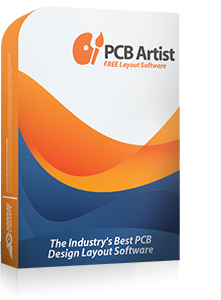
PCB Artist™
Download the best FREE PCB design software with a components library of over 500,000 parts. Click Here»
Printed circuit board (PCB) design has become increasingly challenging with the introduction of high-density boards that must provide more functionality in less space. With boards being designed for technologies such as smart phones, tablets, appliances, home automation, and even children’s toys, electronics and PCBs are integrated into nearly every device we come in contact with.
Designing smaller boards with tighter routing and larger numbers of components results in associated board layout complexity. PCB layout software can therefore become almost mandatory for designing effective layouts that can be successfully transformed into a working product, whether for prototypes or production-ready boards.
PCB layout software can contribute to design and production efficiency in a number of ways:
- Storing of templates for reuse – no need to re-invent a new layout when one has been created in the past that has similar functionality. Starting from a working template ensures that the process starts with a time-proven design, and adding/removing components from that point. The result is a shortened development cycle time and improvements in quality.
- Process flow – Layout software enforces best practices for PCB design. By utilizing tools incorporated in the software, designers produce schematics and layouts following standard methodologies and techniques.
- Designing for manufacturing (DFM) – use of PCB layout software specifically designed for this purpose can prevent generation of PCB layouts that look great on paper or a screen, but cannot be duplicated in the world of manufacturing. Many software tools can raise alerts to such conditions.
- Documentation – software tools save layout designs in standard formats for future reference and reuse. Illustrations and layout documents can also be printed for working with manufacturers or for submitting designs for quotes by potential vendors.
- Design Rule Checking (DRC) – verification features like DRC catch problems before they’re designed into the PCB. Based on component types, such functions can ensure that spacing is within tolerances, there are no problems with size limitations, other layout rules that pertain to object types, layers, and much more.
- Ease of placement – layout of the board with drag-and-drop simplicity improves efficiency of layout design.
- Board quality – layout software can analyze complex designs that may result in conflicts between components or circuit paths that may generate problems from track width, physical component or board size, and even electromagnetic interference from other board elements.
PCB Layout Software Functions
PCB layout can be streamlined and optimized by utilizing the software that best suits the needs of the designer. Some functions are present in many software offerings, while others go a step or two further with greatly enhanced tools for the layout process.
Selecting Layout Software that Meets Your Needs
Layout software is available in a number of ‘flavors’ and they are not all created equal. There are some conditions or missing functionality that should raise a red flag when selecting the right layout tool, and others that are dead giveaways that a PCB designer should look elsewhere.
- Functionality that matches the work style of the designer – many designers start from a schematic, and move the results into PCB layout design. If the software being considered doesn’t support that flow, it’s probably best to select another system.
- Flexibility – Creating a great layout is one thing, but if that’s the end of the program’s functionality, it has not provided a great value. It’s important that there is flexibility provided to check the layout for potential manufacturability errors, then move on to completing the PCB design. Layout software should also accommodate designs for both rigid and flex boards, where it applies to the needs of the designer.
- Support – Does the vendor provide effective support for the software? Especially for designers new to CAD tools, initial support for software functions and questions will be a requirement.
- Updates – How often does the software vendor update the program? PCB layout and design is evolving continuously with technology. Software that doesn’t change with the times will be useless in a relatively short period of time.
Utilizing PCB Layout Software to Your Advantage
Introducing layout software to the PCB design process will improve the efficiency of component placement and reduce the number of issues encountered when boards go to prototyping and final fabrication phases. The earlier in the process problems are discovered, the less costly it is to address and correct them.
This becomes even more critical as engineers are tasked with designing more complex, multi-layer, thinner PCBs for advanced electronics and miniaturized devices. Smartphones and smart flat-screen televisions are just some examples of applications for increasingly sophisticated PCB layouts.
Putting layout software to work in your PCB design flow will improve quality, produce designs ready for manufacturing, speed time to market, and reduce costs.







